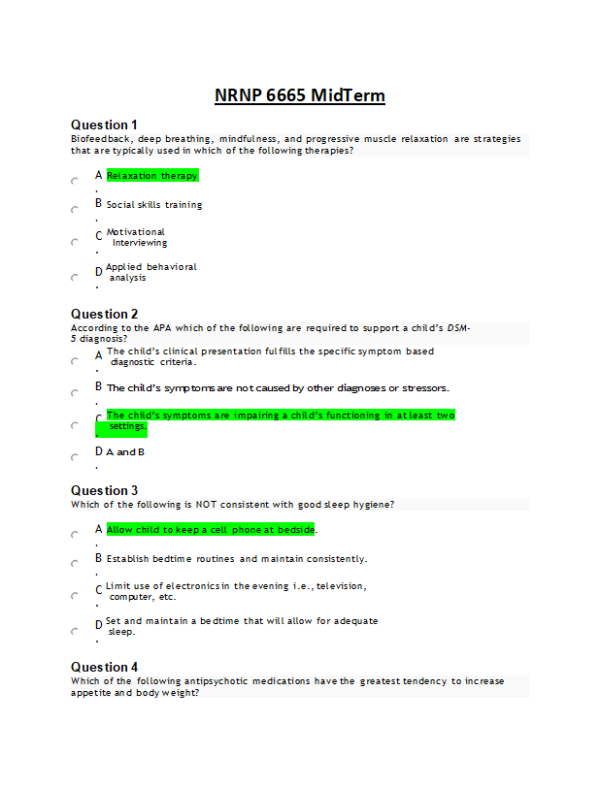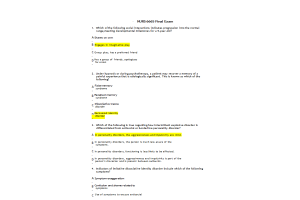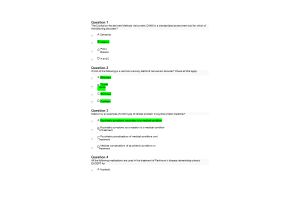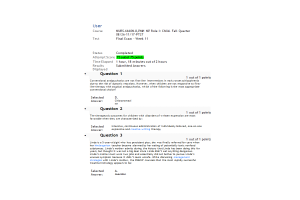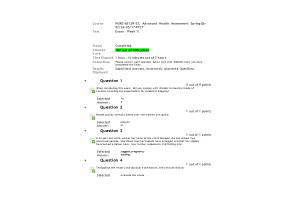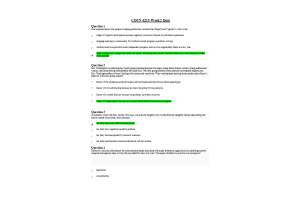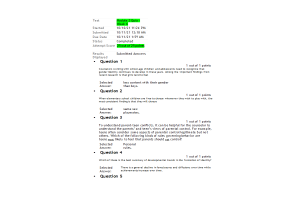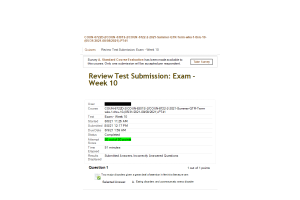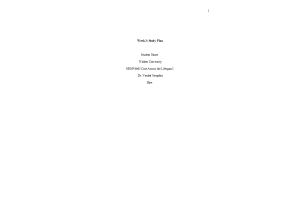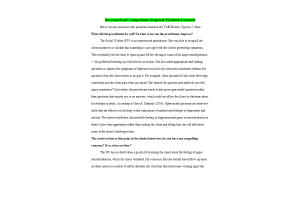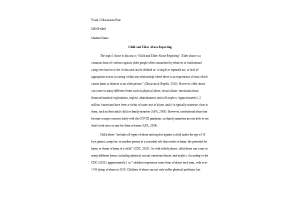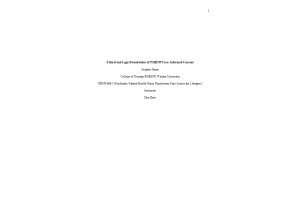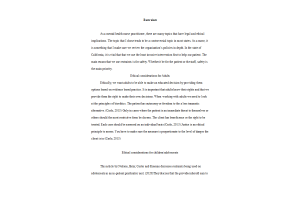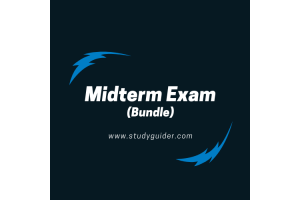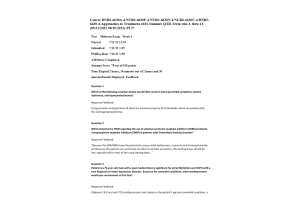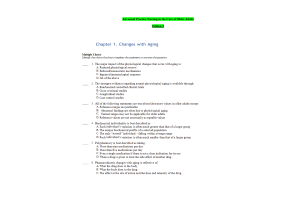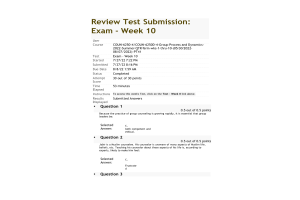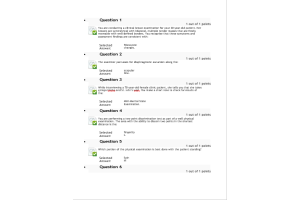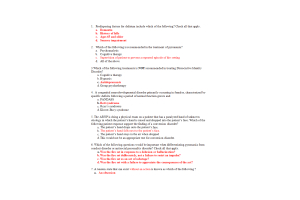NRNP 6665 Week 6 Midterm Exam (100% Correct Summer QTR)
- $49.00
1. Question: Biofeedback, deep breathing, mindfulness, and progressive muscle relaxation are strategies that are typically used in which of the following therapies?
2. Question: According to the APA which of the following are required to support a child’s DSM- 5 diagnosis?
3. Question: Which of the following is NOT consistent with good sleep hygiene?
4. Question: Which of the following antipsychotic medications have the greatest tendency to increase appetite and body weight?
5. Question: When assessing a child with disruptive or aggressive behavior, the clinician asks “Have you been thinking about or planning to hurt anyone?” to screen for which of the following diagnostic categories?
6. Question: The clinician assessing substance abuse in an adolescent asks, “Did you develop more mood or anxiety problems after you started using?” to screen for which of the following diagnostic possibilities?
7. Question: When the patient lacks capacity to make a decision the nurse has the ethical responsibility to do which of the following?
8. Question: When assessing a child who has presented with concerns of being anxious and worried, the provider asks the child “Do you get sudden surges of fear that make your body feel shaky or your heart race?” to screen for which of the following common diagnostic possibilities?
9. Question: Which of the following antipsychotic medications has the greatest risk for weight gain and lipid changes?
10. Question: A period of at least one week in which both a manic episode and a major depressive episode occur almost daily is consistent with which diagnosis?
11. Question: Which of the following is NOT true about symptomatology of anorexia nervosa?
12. Question: Sleep-related hallucinations occurring at sleep onset are known as which of the following?
13. Question: The theory that depression results from specific thought distortions is consistent with which of the following?
14. Question: Reasons for the underuse of specific mental health treatments during childhood include which of the following?
15. Question: Which of the following is true regarding the cultural formulation interview with a child and caregiver?
16. Question: According to the APA, “Psychologists seek to promote accuracy, honesty, and truthfulness in the practice of psychology,” reflecting which of the following ethical principles?
17. Question: Which of the following antidepressant medications have the greatest tendency to increase appetite and body weight?
18. Question: Which of the following is the most common eating disorder?
19. Question: ADHD, impulse-control, conduct disorder, and intellectual disabilities and anxiety disorders are predominant during which of the following age ranges?
20. Question: The clinician asks the child who is being seen for labile mood “Have you felt really down depressed or uninterested in things you used to enjoy for more than 2 weeks? to screen for which of the following diagnostic categories?
21. Question: Which of the following disorders is characterized by episodic bouts of intake of excessive amounts of food but without purging or similar compensatory behavior?
22. Question: During the evaluation of a patient with a history of Bipolar I Disorder, who is manic, the patient states that she is actually the Queen of England and quite wealthy. This is an example of which of the following?
23. Question: A form of cognitive behavioral therapy (CBT) that requires attending skills groups in addition to individual therapy sessions are known as which of the following?
24. Question: Which of the following is consistent with recommendations for use of available evidence- based psychopharmacological interventions?
25. Question: The type of therapy typically indicated for individuals with chronic and significant suicidality and self-harm is known as which of the following?
26. Question: The average time from the start of child mental health symptoms until a young person enters mental health treatment is which of the following?
27. Question: A general term for programs that teach and encourage skillful parent and caregiver responses to challenging child behaviors.
28. Question: Nightmares and night terrors are associated with disorganization and arousal during which stage of sleep?
29. Question: The right to assent of dissent from treatment for a child or adolescent is reflected in which of the following American Academy of Child and Adolescent Psychiatry ethical issues?
30. Question: In the event of a crisis in which the child is threatening to hurt himself, the first steps should include which of the following?
31. Question: A 10-year-old child presents with developmentally inappropriate and persistent difficulty with inattention with symptoms which are interfering with academic goals and in social settings. This is consistent with which of the following diagnoses?
32. Question: A patient presents endorsing persistent low-grade (sub-acute) depression for the last several years, uncertain of when it started, thinks he has always been depressed but still goes through the motions. These symptoms are consistent with which of the following diagnoses?
33. Question: Examples of atypical features in a patient with Major Depressive Episode include which of the following?
34. Question: Somnambulism is characterized by which of the following?
35. Question: A 15-year-old girl presents with symptoms that include restrictive eating and food avoidance, with a desire to avoid obesity, which persists despite negative consequences. This presentation is consistent with which of the following diagnoses?
36. Question: Which of the following antidepressants are approved by the FDA for treating depression in children ages 8–17?
37. Question: When assessing for substance abuse in an adolescent, the clinician should initially assess for which of the following?
38. Question: Which of the following is consistent with what is known about prevalence of Bipolar I disorder?
39. Question: Which of the following is NOT consistent with the code of ethics for the nursing profession?
40. Question: Which of the following is NOT consistent with what is known about anorexia nervosa?
41. Question: The mental health practitioner realizes the following about using a behavioral health rating scale?
42. Question: When responding to a family member about the genetic factors related to mood disorders the APRN would share which of the following?
43. Question: Which of the following medications are approved by the FDA for treating OCD in children ages 6–17?
44. Question: Universal sleep hygiene would NOT include which of the following?
45. Question: Which of the following is NOT consistent with pseudodementia seen in major depressive disorder?
46. Question: When evaluating a child due to disruptive or aggressive behavior, which diagnostic category should be considered first?
47. Question: Which of the following may be symptoms of depression in children?
48. Question: Which of the following would be consistent with ethical principles regarding relationships with patients in the ANA’s Code of Ethics for Nurses (Provision 1.2)?
49. Question: The domain of ethics concerning the nature of ethics and moral reasoning is known as which of the following?
50. Question: A dissociation between the patient’s experience of sleeping and the objective polygraphy measures of sleep is known as which of the following?
51. Question: The American Academy of Child and Adolescent Psychiatry Code of Ethics Principle II: Promoting the Welfare of Children and Adolescents addresses which of the following ethical issues?
52. Question: Ethical questions about what we “ought” to do or be are addressed within which domain ethics?
53. Question: The most powerful predictors of the onset of a depressive episode is which of the following?
54. Question: Attempts to influence providers through use of dinners, gifts, educational opportunities, and medication samples provide a conflict from which of the following American Academy of Child and Adolescent Psychiatry ethical perspectives?
55. Question: Which of the following SSRIs is a first line treatment for depression in children?
56. Question: When evaluating a child/adolescent who presents with irritable or labile mood the clinician should first consider and screen for which of the following diagnostic categories?
57. Question: The ARNP asks the teenager, who according to parents has been extremely moody, “Have you been using drugs or alcohol?” to assess for which of the following diagnostic possibilities?
58. Question: Which of the following are medical complications NOT associated with anorexia nervosa?
59. Question: Principles to be considered when using a rating scale to assess for mood and anxiety disorders include which of the following?
60. Question: Hypersomnolence disorder (excessive sleeping) can be caused by which of the following?
61. Question: Which of the following questions should be considered prior to prescribing any medication?
62. Question: Strategies that enhance therapeutic engagement include which of the following?
63. Question: Which of the following is true about educating children and their families about their diagnosed mental health disorder?
64. Question: Which of the following BMIs is associated with severe anorexia nervosa?
65. Question: Developmental impairments and disruptive behavior problems are predominant issues during which of the following age ranges:
66. Question: Applied behavioral analysis is typically indicated for which of the following disorders?
67. Question: A distinct period of an abnormally and persistently elevated, expansive or irritable mood lasting at least a week or requiring hospitalization is consistent with which of the following?
68. Question: A patient in their early 20s presents reporting chronic fluctuating moods ranging from mild depression to at times some hypomania. Recalls being sensitive and moody as a child. These symptoms are consistent with which of the following diagnoses?
69. Question: The comorbid psychiatric condition most frequently associated with anorexia nervosa is which of the following?
70. Question: When evaluating a child with poor academic performance which of the following diagnostic categories should be considered first?
71. Question: Which of the following is NOT an American Academy of Child and Adolescent Psychiatry (AACP) Code of Ethics?
72. Question: The APRN would recommend which of the following be included in a post-crisis plan?
73. Question: Which of the following medications is approved by the FDA for treatment of enuresis?
74. Question: In evaluating an adolescent with recurrent and excessive physical complaints, the clinician would first consider all of the following prior to which other diagnostic possibility?
75. Question: Which of the following is NOT consistent with what is known about socioeconomic and cultural factors related to mood disorders?
76. Question: “Is it ever right to deceive a research subject?” is a question which specifically falls under the category of which of the following domain of ethics?
77. Question: The two neurotransmitters most implicated in the pathophysiology of mood disorders are which of the following?
78. Question: The strongest predictors of a future suicide completion include which of the following? Check all that apply.
79. Question: Which of the following would be an initial screening question for a child with sleep problems?
80. Question: Which of the following hormone levels is increased in anorexia nervosa?
81. Question: Which of the following medications are approved by the FDA for treatment of mania in children ages 12–17?
82. Question: The most common age of onset of anorexia nervosa is which of the following?
83. Question: Which of the following medications is considered a first-line treatment for anxiety in children?
84. Question: Which of the following medications is FDA approved for the treatment of bulimia?
85. Question: Time-consuming internal repetitions of unwanted thoughts and or a persistent focus on repeating specific types of behaviors or mental acts are symptoms consistent with which of the following diagnoses?
86. Question: Which of the following is true about social skills training with teens?
87. Question: Which of the following symptoms are associated with Major Depressive Disorder with Melancholic Features?
88. Question: The ANA’s Code of Ethics for Nurses applies to which of the following EXCEPT:
89. Question: Which of the following medications are approved by the FDA for treating generalized anxiety disorder in children ages 7–17?
90. Question: Which of the following symptoms assists in differentiating purging disorder from bulimia nervosa?
91. Question: Which of the following is important to realize when treating a child with an anxiety disorder?
92. Question: A therapy focused on readiness to change related to health behaviors is known as which of the following?
93. Question: Which of the following is NOT consistent with guidelines for obtaining informed consent involving child/adolescents?
94. Question: Major depressive disorder, eating disorders, and substance use disorders predominate at which of the following ages?
95. Question: The clinician asks the child who is anxious/worried, “Is there something in particular or a situation that makes you immediately afraid?” to screen for which of the following diagnostic categories?
96. Question: Which of the following should first be considered when assessing a child with sleep problems?
97. Question: The clinician asks an adolescent “Have you felt persistently sad or gloomy for more than a year?” to assess for which of the following common diagnostic possibilities?
98. Question: Which of the following medications are FDA approved for the treatment of insomnia?
99. Question: Which of the following medications are approved by the FDA for treating obsessive- compulsive disorder in children ages 10–17? Check all that apply.
100. Question: Which of the following medications is FDA approved for the treatment of Major Depressive Disorder with Seasonal variation (previously known as Seasonal affective disorder)?
